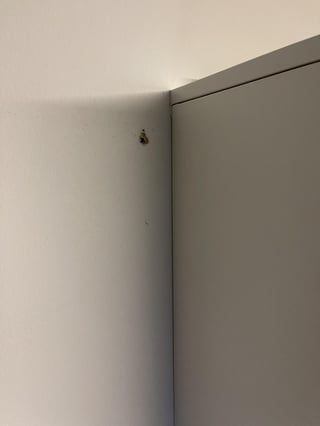Continuing from Solar Mike's excellent answer:
Use a longer screw. However, one must be sure that there is no electrical or plumbing behind that point that could be penetrated by the longer screw.
Put the screw somewhere else vertically. It may mean drilling a hole in the back of the cabinet to run the screw through instead of using the predefined hole. However, this shouldn't be a concern, as the cabinets I installed didn't have any holes in them at all and I had to make my own screw holes in them. Of course, if this is a cardboard-backed cabinet, that won't work, but there is no indication of whether this is the case or not.
Based on the second image posted and the updated description:
I would not rely on just the bottom hole on one side of the cabinet. The cabinet acts as a lever trying to pull the screw out of the wall. The lower the screw is, the longer the lever pulling against it. At the top, you've got a very short lever arm and not as much force, lower down, you've got a longer arm and thus more force. I'd suggest using both top & bottom holes.
Since the back of the cabinet is steel you can easily drill a new hole through it near the existing hole, then drive your screw through the new hole and directly into the stud. I would move the mounting bracket down to meet the new hole. Since the bracket is also designed to screw into the side rail of the cabinet, I would use the holes in the bracket as a template to drill new holes into the side rail of the cabinet and screw it in its new, lower position.
Since your screw snapped, you'll need to get new screws. I suggest that you get "cabinet" screws. They are designed for holding well in wood and have a built-in washer to help spread the load across the back of the cabinet wall instead of just the small point of a "regular" screw head.
Also, you mention "only" storing a few light items up to 10KG in this cabinet. That's all well and good until you forget and start loading it up with dishes, or run out of space and need to put some liquids up there, or you move out and the next person doesn't know you've done a rubbish job of installing the cabinet. If you're going to do this, DO IT RIGHT!




